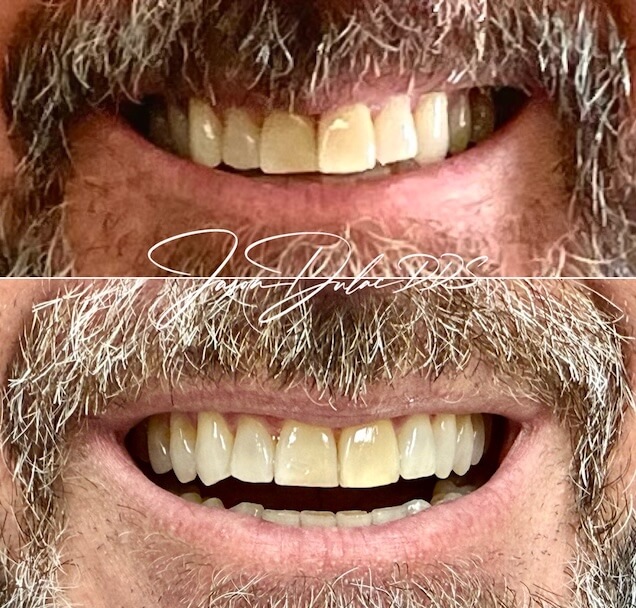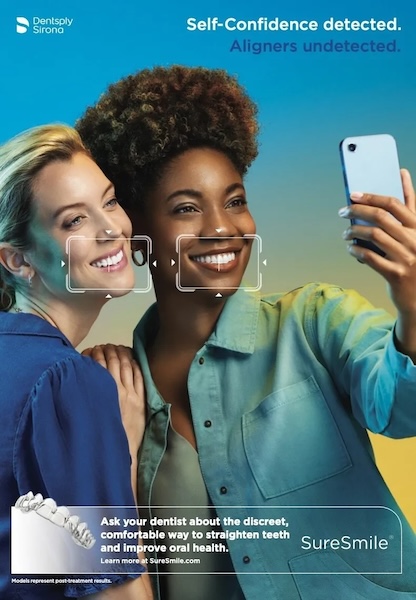What is Clear Aligner Therapy?
Half a century ago, orthodontic treatments involved rigid wires and problematic brackets that applied significant force to the teeth. This often led to root resorption and various issues, causing discomfort and pain for individuals undergoing these procedures. The common perception was that braces were painful.
Today, there's a revolutionary approach known as clear aligner therapy. In contrast to traditional methods where wires move the teeth, clear aligner trays are utilized to achieve the same result. This innovative technique minimizes discomfort and provides a more comfortable experience for individuals seeking orthodontic treatment.
How does Invisalign compare to other Clear Aligner Therapies?
Invisalign is a well-known brand name, but we also offer other Clear Aligner Therapies at our office that I believe may be more effective for some patients.
What is the process for starting Clear Aligner Therapy?
The process includes a consultation to ensure the therapy is right for the patient, a scan of the teeth to design the case, and ordering the aligners.
Approximately one-third of the way into the treatment, a remarkable transformation occurs, and you'll experience genuine happiness—a kind of internal reward. It's akin to the satisfaction of going to the gym and gradually feeling better; although it takes a few weeks, the positive changes become evident. Midway through an Invisalign case, people often gain increased confidence in their smile. Witnessing this transformation is truly gratifying.
Six months post-treatment, when I see individuals again, their increased happiness and confidence are unmistakable. It's a rewarding feeling to observe them smiling more freely. Moreover, in my practice, we offer complimentary teeth whitening with every Invisalign case. You can use the aligner trays as whitening trays, and I provide free bleach for each case. This means that not only will your teeth be straighter, but they will also be visibly whiter, enhancing their appearance. The result? A brighter smile that stands out, leading to more smiles in family photos. Overall, the results are bound to make you exceedingly happy.
How does Invisalign or Clear Aligner Therapy compare to traditional braces?
With traditional braces, the wire moves the teeth and the brackets position them. In Clear Aligner Therapy, the aligners position the teeth. Both methods are offered at our office. Additionally, we offer functional orthodontic appliances designed to encourage jaw and bone growth, providing a range of options for our patients. In our office, we prioritize tailoring the treatment to your specific needs.
If I determine that Clear Aligner Therapy might not be the optimal choice for your situation, I'll be upfront about it. We collaborate with a network of skilled specialists in the area. In cases where a multidisciplinary approach is necessary for a complex situation, we coordinate with oral surgeons, orthodontists, and any other specialists required to ensure you achieve the desired results. My recommendation will always be based on what I believe is best for you and aligns with your goals.
Is Invisalign faster than braces?
Invisalign and braces move teeth at the same speed.
Why is Clear Aligner Therapy considered more comfortable than braces?
Clear Aligner Therapy is considered more comfortable because the plastic aligner can't put too much force on the teeth, unlike traditional orthodontic therapy. Plus, aligners don't cause rawness in the mouth like wires and brackets can.
How long does Clear Aligner Therapy or Invisalign take to straighten teeth?
The duration varies per person and case, but most cases take around six to nine months.
What is the process involved in Invisalign or Clear Aligner treatment?
The process involves a consultation, a scan of the teeth, designing the case, and fitting the aligners two weeks later.
What are Invisalign trays and how many will I need?
Invisalign trays are the aligners that go on the teeth. The number needed depends on the case, with each tray moving each tooth 0.1 to 0.2 millimeters. To achieve the desired movement of your teeth, we typically use trays that are worn for about ten days, but there's some flexibility, and most individuals find success within one to two weeks. The total number of trays needed varies based on the complexity of the case, generally ranging from five to ten trays.
You won't need to visit the office for every tray change. Instead, I provide you with a comprehensive set of trays, allowing for a more convenient process. Additionally, I can remotely assess the fit of the trays, minimizing the need for frequent in-person visits. The treatment involves an initial visit, a final visit, and a few in-between visits that can easily be conducted over platforms like Zoom or FaceTime, or through shared photos. This streamlined approach aims to make the process more accessible and convenient for you.
Should I sleep with Invisalign trays?
Absolutely, it's crucial to emphasize that the effectiveness of the treatment is directly tied to your commitment to wearing the trays for approximately 22 hours a day. This level of dedication is essential for achieving the desired results. When investing both time and money in this process, it's vital to ensure you are fully committed to wearing the trays consistently.
While taking the trays out for eating is necessary, it's important to limit the time they are not in use. Special occasions or social events are exceptions, allowing for a more flexible time frame of around six hours. However, for the majority of the day and night, keeping the trays in is imperative to make progress. It's worth noting that some individuals find this commitment inadvertently helps with reducing snacking and even contributes to weight loss.
Can anything disqualify me from using Invisalign?
Rarely, but teeth that are not healthy, free of decay, or gum disease can disqualify a patient. However, these cases are rare. In terms of orthodontic treatment options, Invisalign is incredibly versatile and can address a wide range of movements. However, there are a few specific cases where Invisalign may not be the ideal choice. In such instances, we also offer traditional orthodontic therapy and functional appliances to cater to diverse needs.
We have the flexibility to combine Invisalign therapy with functional orthodontic appliances for a comprehensive approach. In rare cases where traditional braces may be more suitable, we can explore that option, though it's infrequent. It's worth noting that Invisalign is now available for teenagers, but success depends on their cooperation. While many teens may not be the most compliant, if there is a commitment to wearing the aligners consistently, they can still achieve positive results. Ultimately, we strive to tailor our approach to each individual's unique needs and circumstances.
Can Invisalign or clear aligner therapy fix a crossbite?
A crossbite occurs when the upper and lower teeth are either underlapping or overlapping. Typically, people's outer teeth extend beyond their inner teeth, but in a crossbite, this alignment is reversed.
In my opinion, Clear Aligner therapy, such as Invisalign, is often the most effective way to address a crossbite. This condition requires separating the teeth to facilitate correction. With traditional braces, a common approach involves adding bumps or steps to the teeth to prevent them from fully closing, enabling the crossbite to be corrected over time.
What sets Invisalign apart is that the trays naturally keep the teeth apart, allowing them to correct on their own without the need for additional modifications. It's important for patients undergoing crossbite treatment to be aware that there will be a phase during which their teeth align edge to edge, which may feel uncomfortable. However, this adjustment is temporary, and throughout the treatment, your bite will be changing. By the end of the process, your bite will likely be improved compared to its initial state.
Is Invisalign or clear aligner therapy painful?
It is not painful, although patients may feel pressure on the teeth for the first 12 hours of each new aligner.
Does dental insurance cover orthodontic therapy?
The coverage for orthodontic treatments, including Invisalign, varies depending on the insurance carrier and specific plan. In our office, we have a dedicated team of four professionals who specialize in handling insurance matters. Before initiating any treatment, whether it's Invisalign or another procedure, we make it a priority to check your insurance benefits on your behalf.
It's worth noting that while some individuals may have comprehensive coverage for orthodontic treatments, particularly for teens, many insurance plans also include coverage for adult orthodontics. If you have this benefit, it's essential to utilize it because, in some cases, if it goes unused, you may lose it. If adult orthodontic treatment aligns with your interests and you have the coverage available, it's a worthwhile opportunity to explore and consider moving forward. Rest assured that our team is here to navigate the insurance details for you.
Why shouldn't I just do it online myself?
A common question I often receive is, "Why shouldn't I just do it online myself?" There are several reasons for this. One major example is Smile Direct Club, a widely known online option, which has filed for bankruptcy. While some patients may have successfully undergone minor movements through online platforms, it comes with inherent risks.
Attempting orthodontic treatment without professional supervision can lead to complications. It's crucial to understand and weigh these risks before deciding. I strongly advise against opting for unsupervised care. Instead, consider coming in for a consultation, which is only $49 in our office. During the consultation, I can assess your case and provide personalized recommendations.
Patients who have tried online options without professional guidance have sometimes ended up dissatisfied with the results. Fixing the issues afterward can be more time-consuming and expensive than getting it right from the beginning. While online options may work in certain cases, I cannot endorse them due to the lack of supervision. Your health is not something to gamble with, and I would always advise seeking professional guidance for orthodontic treatments.
Is Invisalign or Clear Aligner Therapy right for me?
Certainly! In most cases, scheduling a consultation is the first step. Simply give us a call, and we'll arrange for you to come in. During the consultation, we'll walk you through the entire process, addressing any questions or concerns you may have. If you're interested in moving forward, we can take a scan to provide you with a visual representation of how the treatment will proceed, including the expected duration.
I'm here to answer any questions you may have, and I'm eager to discuss the options available to you. Setting up a consultation at the office is the best way to get started, and I look forward to helping you achieve the smile you desire. You can reach us at (703) 451-4500. You can text or call this number.

Invisalign® is the invisible way to straighten teeth without braces. Using advanced 3-D computer imaging technology to project tooth movement, Invisalign® creates a series of clear, customized aligners that gradually straighten your teeth over time. Each aligner is worn for 7-10 days, before advancing to the next set, until the goals you established with your dentist are reached. Invisalign® is a great option for patients who want straight teeth without traditional brackets and wires. Dr. Dulac is an Invisalign provider in Springfield, VA!
Dr. Dulac is proud to also offer SureSmile clear aligner therapy.


